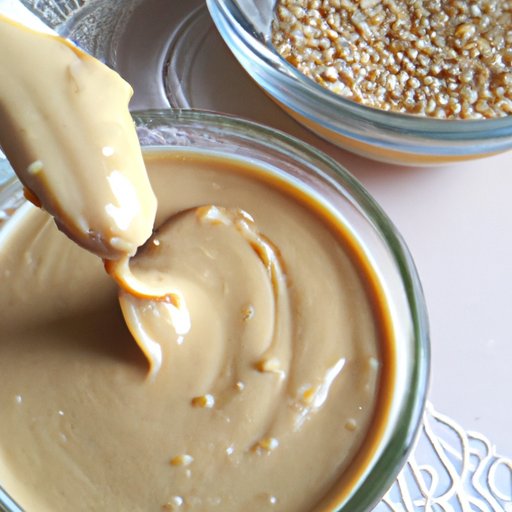Introduction
Tahini is a paste made from ground sesame seeds, and it has been enjoyed around the world for centuries. It is often used in Middle Eastern, North African, and Mediterranean dishes, and it is also a popular ingredient in sauces, dressings, and dips. But is tahini healthy? In this article, we’ll explore the nutritional benefits of tahini, how it can be incorporated into your meals, and the role it plays in Mediterranean cuisine.
Is Tahini a Healthy Alternative to Other Spreads?
When it comes to spreads, there are plenty of options to choose from. But is tahini healthier than the alternatives? To answer this question, let’s compare the nutritional profiles of tahini and other popular spreads. According to the USDA, one tablespoon of tahini contains 89 calories, 7.9 grams of fat, 2.5 grams of carbohydrates, and 1.7 grams of protein. In comparison, one tablespoon of peanut butter contains 94 calories, 8.3 grams of fat, 3.2 grams of carbohydrates, and 2.6 grams of protein.
While both tahini and peanut butter are relatively high in fat, tahini is lower in calories and carbohydrates. Additionally, tahini is a good source of calcium, iron, and other minerals. These nutrients can help support bone health, reduce inflammation, and promote overall wellness. So when comparing tahini to other spreads, it’s clear that tahini is the healthier option.

How Tahini Can Help Improve Your Diet
In addition to its nutritional benefits, tahini can also help you improve your diet in other ways. For example, adding tahini to your meals can help add variety and flavor. Tahini can be used as a dip for vegetables or as a spread on sandwiches and wraps. It can also be used as an ingredient in dressings and sauces, giving your meals a delicious nutty flavor.
Tahini can also be used to substitute fattier ingredients. For instance, you can use tahini instead of butter or mayonnaise in your recipes. This can help reduce the amount of saturated fat and calories in your meals without sacrificing flavor.
What Makes Tahini a Nutritional Powerhouse?
Tahini is a nutritional powerhouse due to the abundance of vitamins, minerals, and other nutrients it contains. One tablespoon of tahini contains approximately 12 percent of your daily recommended intake of calcium, 8 percent of your daily recommended intake of iron, and 6 percent of your daily recommended intake of magnesium. It is also a good source of zinc, copper, and manganese.
These essential minerals are important for maintaining strong bones, reducing inflammation, and promoting overall health. Additionally, tahini is a good source of fiber, which is important for digestion, and it is also rich in heart-healthy unsaturated fats.

The Role of Tahini in Mediterranean Cuisine
Tahini is a staple ingredient in Mediterranean cuisine, and it is used in many popular dishes. Hummus, for example, is a popular dip made with tahini, chickpeas, garlic, lemon juice, and spices. Baba ghanoush is another popular dish made with tahini, eggplant, garlic, and lemon juice. Tahini is also used in dressings, sauces, and even desserts.
Exploring Mediterranean recipes featuring tahini can be a great way to add variety and flavor to your meals. You can also experiment with different ingredients to create your own unique recipes. Whether you’re looking for a new dip or a way to add flavor to your salads, tahini is a great option.
Understanding the Nutritional Profile of Tahini
As we’ve seen, tahini is a nutritional powerhouse. But what exactly makes it so nutritious? Let’s take a closer look at the macronutrients and micronutrients present in tahini.
Tahini is a good source of both macronutrients and micronutrients. It is rich in healthy monounsaturated and polyunsaturated fatty acids, which are essential for maintaining heart health. Tahini is also a good source of protein, which is important for supporting muscle growth and repair. Additionally, tahini is a good source of dietary fiber, which can help support digestion.
In terms of micronutrients, tahini is an excellent source of calcium, iron, and other minerals. Calcium is important for maintaining strong bones, while iron helps carry oxygen throughout the body. Additionally, tahini is a good source of zinc, copper, and manganese, which are all important for promoting overall health.
Conclusion
Tahini is a popular spread that’s been enjoyed for centuries. It is a nutritional powerhouse due to its high content of vitamins, minerals, and other essential nutrients. Additionally, tahini is a great alternative to other spreads, as it is lower in calories and carbohydrates. Tahini can also be used as an ingredient in dressings, sauces, and dips, and it is a staple in Mediterranean cuisine.
From its numerous health benefits to its versatility in the kitchen, tahini is an excellent addition to any diet.
(Note: Is this article not meeting your expectations? Do you have knowledge or insights to share? Unlock new opportunities and expand your reach by joining our authors team. Click Registration to join us and share your expertise with our readers.)
